U.S. Department of Transportation
Federal Highway Administration
1200 New Jersey Avenue, SE
Washington, DC 20590
202-366-4000
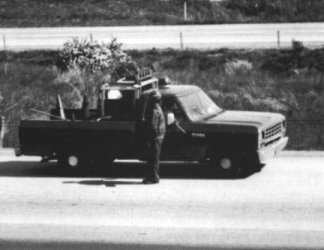
U.S. Department Of Transportation
Federal Highway Administration
Office of Highway Safety
FHWA-RT-00-00
I. Importance of Maintaining the Sign Face
II. Repair and Replacement of Sign Panels
III. Repair and Replacement of Small Sign Supports
IV. Cleaning and Checking Signs and Sign Supports
V. Materials and Equipment Used in Maintaining Signs
VI. Traffic Control During Sign Maintenance
VIII. Resource Material
This handbook is intended to help maintenance workers understand the importance of well-maintained signs and provide information that will help them in accomplishing that task. Well-maintained signs are important to drivers in making good decisions.
Many signs require or advise the drivers to take specific actions. These signs must be clean, legible, used correctly and in good condition to command the respect of a driver.
There are three major kinds of signs that provide the driver with the "Rules of the Road" and provide guidance and information for efficient traffic flow.
There are also special signs for use in work zones or to direct people to special events, but they all fit into these three categories.
Doing a good job of maintaining regulatory and warning signs makes the road safer for all drivers. You should keep in mind that an accident can occur because of a missing or unreadable sign. Good sign maintenance will improve traffic safety, reduce the chances of a lawsuit against the community, and increase traffic capacity. Remember "TRAFFIC SIGNS MUST HAVE A PURPOSE"- they must:
Missing or damaged signs can be identified through accident reporting procedures established with the police, ongoing police observations, field reviews (particularly after wind and ice storms), reports from citizens or observations of employees during working hours, in travel to and from work, or at any other time (day or night).
Regulatory signs are the most important to the driver because they represent the laws and regulations that are enforceable. They usually require a driver to take a specific action, such as STOP, but can also deny the driver right of entry, such as DO NOT ENTER. Failure to respond to a regulatory sign can result in or contribute to a severe accident. This can occur when a driver doesn't see a regulatory sign or sees the sign too late and makes an erratic movement. Missing, damaged, or ineffective regulatory signs constitute a potential hazardous condition.
Common regulatory signs include STOP, YIELD, SPEED LIMIT, DO NOT ENTER, DO NOT PASS, ONE WAY, and WRONG WAY.
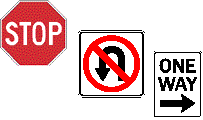
Damaged or missing regulatory signs (especially STOP, YIELD, DO NOT ENTER, ONE WAY and WRONG WAY signs) should be replaced or repaired as soon as possible. Generally, these signs should be replaced or repaired within hours of the agency having notice of them missing, down, or damaged. The date and time of notification should be documented, and should be followed up with the date and time the sign was repaired or replaced.
Warning signs are the second most important group of signs because they are essential to the driver in making important decisions on how to operate the vehicle. Warning signs provide drivers with information that is necessary for controlling their vehicle. The proper use and maintenance of warning signs help prevent what is often called "OVER DRIVING THE ROAD" because warning signs provide drivers with advanced notice of potentially hazardous situations or conditions on the road ahead. Common warning signs include: STOP AHEAD, YIELD AHEAD, TURN, SHARP CURVE, RAILROAD CROSSING AHEAD and SPEED WARNING signs.
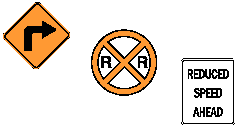
Damaged or missing warning signs (especially speed advisory plates, sharp curve signs, railroad crossing and stop ahead signs) should be replaced or repaired as soon as possible. Generally, a sign should be replaced as soon as it is identified as being lost or damaged. As a general rule, the situation should be corrected within three calendar days and the action taken, date and time documented.
Guide signs are the third type of signs commonly used on highways and roads. Guide signs generally provide the driver with navigational information, which, while important, is not as important as the regulatory or warning signs. Guide signs are usually used to help a driver get to a particular location. The absence of a guide sign may not be noticed by a driver; however, there are situations where the absence of a guide sign, particularly a sign in a series of signs, can confuse a driver. Confused drivers are much more likely to contribute to accidents because they are "Not Focused on the Driving Task". Additionally, confused drivers often make erratic maneuvers, such as slowing or stopping in the roadway, backing down ramps, or making abrupt turns. Common guide signs include EXIT (for a location), REST AREA, STREET NAMES, AIRPORT.
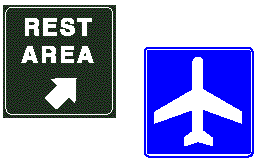
Replacement of damaged or missing guide signs should be done as soon as possible, but not take priority over replacement; or repairs of either regulatory or warning signs. Maintenance of guide signs requires your judgment; if you think the absence or damage to the guide sign could result in driver confusion, replace it as soon as possible. If you don't think the sign is critical, you should repair or replace it when practical, generally within two weeks. Again the action taken along with the date and time it was taken should be documented.
Work zone and special signing, such as those signs used at special events to direct traffic, must be maintained and used correctly to insure both the safety of the motorist and of the highway worker or persons working on or adjacent to the highway. Because both work zone and special signs often require drivers who are familiar with the road to do something differently, it is extremely important to use the correct signs and replace them immediately if damaged or lost. Because work zone signs are used for both scheduled and unscheduled activities, they must be in excellent condition. This is particularly true of their retro-reflective surface, which must be highly visible both day and night. Common work zone signs include FLAGGER AHEAD, MERGE, and SPEED
LIMIT signs.
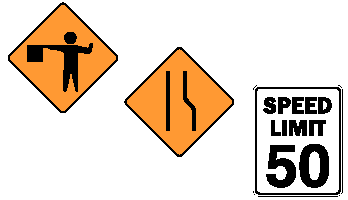
Damaged or missing work zone signs should be replaced immediately. Because they are often used in conjunction with existing signs, existing signs that are damaged or lost and are important to traffic safety and control should also be replaced immediately. It is a good practice to carry extra common work zone signs in maintenance vehicles. To protect the retro-reflectivity of the sign faces it is also important to handle and store the signs properly, and always remove or cover work zone signs when they are not needed.
When signs are damaged, bent or vandalized, you have to determine if the sign should be repaired, replaced or left as is. This is usually a field judgment-more often than not, it is cheaper to replace a badly damaged or unreadable sign than attempt many repairs. Consider the repair costs, remaining service life of the sign face after repairs and the value of the sign blank (when it is reusable) against replacing it with a new or recycled sign. Do not leave a sign down or take a sign away and leave nothing. Always try to have a replacement sign or sufficient repair materials with you. If you decide a field repair is appropriate or you have to repair the sign until a replacement sign can be obtained, consider the following points:
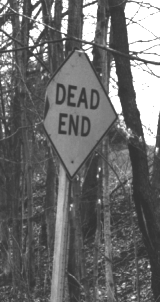 |
Bent Signs Replacement Signs may be bent like this DEAD END sign. While many bent signs can be read in the daylight, some bent signs, even signs with minor bending, are difficult to see at night because they no longer reflect the light from the vehicle's headlights back to the driver's eyes. Minor bending like this may be repaired by removing the sign from the post and straightening the sign face. |
Accident Damaged Signs and Sign Supports
Replacement
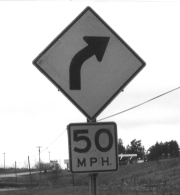 |
The sign face is cracking. Retroreflective surfaces that have splits, breaks, peels, or separations should be replaced as soon as practical with a new sign. |
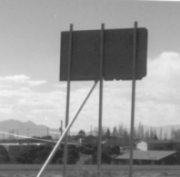 |
Sign supports should be repaired or replaced to original conditions. This "breakaway" support was propped up with a diagonal brace, which could affect its safe performance if it were hit again. |
When a sign requires repeated maintenance, consideration should be given to the reason why and the possibility of relocation considered.
Repairs
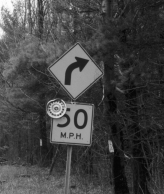 |
This sign is adequate under normal conditions but when tampered with, it can induce a lack of respect in the driver, additionally the drivers attention is diverted from the warning message. Local community employees should be trained to report or resolve such conditions immediately. |
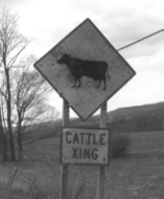 |
This sign is old and the surface is seriously cracked - it has lost its retroreflective characteristic and appears as a distorted image at night. If the signs are still appropriate they should be scheduled for replacement. |
Cracked, crazed, or faded sign faces do not provide adequate night time retroreflectivity.
Damaged signs are often more than just bent signs. They can be damaged as a result of natural actions, accidents, or vandalism.
Signs may also be considered damaged if, because of their retroreflective characteristics and orientation, they cannot be seen at night. These signs sustained both physical and chemical damage and are no longer visible at night. Additionally they should be mounted (remounted) at the appropriate height.

While some signs may be repairable in the field, most will require removal (and replacement), restoration or salvage.
A bent sign can often be fixed simply by straightening. If after straightening the message remains clear, legible, retro-reflective and the sign surface is not opened, cracked or separated from the sign face, it may be reused. Remember, if a sign is so badly bent that it will take several hours to fix, it is often cheaper to replace the sign and leave any repair or salvage to a shop operation. To repair a sign with minor bends, you should:
Signs with scraped faces (usually as a result of being hit) or signs that have holes in them (occasionally as a result of vandalism) are often no longer legible, particularly at night. The damaged areas no longer reflect light back to the driver. These signs often cannot be read at night. While signs with severe damage are usually replaced (to be repaired later in the shop), minor damage can often be repaired in the field.

Field patching can be done by preparing a repair kit that includes the appropriate colors and types of new sheeting materials (including pressure-sensitive adhesive sheeting), cleaners and sealants.

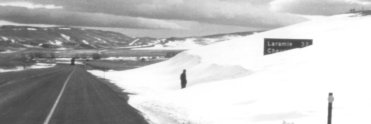
The resolution of problems associated with vandalism should be a part of all sign maintenance programs. Sign vandalism is a growing problem. Signs over-sprayed with paints are difficult to read, particularly at night, and do not demand the respect and attention of a driver. The removal of paint or other materials from the face of a sign can and often does reduce its retroreflective characteristics and therefore its effectiveness. Vandalism also occurs in rural areas where, in addition to overpainting, signs may be the target of disgruntled motorists or hunters or be taken by souvenir hunters.
Spray Paint on Signs
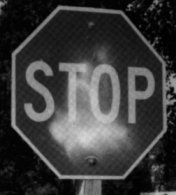 |
This sign has been sprayed with a light colored paint. Everyone who looks at the sign notices it. At night the message becomes hard to read. The safety effectiveness of this sign is significantly reduced and requires immediate attention. |
Missing Signs
Missing signs are also a very significant problem. While signs can be blown down in storms, missing signs are often removed by individuals seeking a souvenir or engaged in what they might consider a "Harmless Prank." Of course a missing sign provides no information for the driver and may create or contribute to a potentially hazardous situation. This is particularly true when the missing signs are regulatory or warning signs.
Bullet hole damage
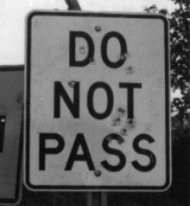 |
This sign has been hit by several gunshots. Even with the holes the sign can be read during the day and functions as intended, but leaving a sign up in this condition does not convey a serious message and may encourage more gun shots to this and other signs. The sign should be replaced or repaired as soon as practical. |
Shotgun blast damage
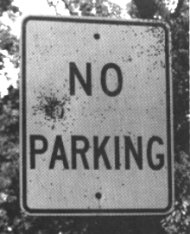 |
This sign has been struck by several shotgun blasts. The retro-reflective material is severely damaged and while the sign is still legible during the day, it is not at night. |
Sign faces that are painted, damaged as a result of shot holes, or being struck by other objects (such as bottles) should be noted and checked later that night to determine if their retroreflective characteristics are acceptable.
Bullet holes and shotgun blasts may be repaired as discussed under damaged signs.
Overpainted signs can often be cleaned but may also require replacement. There are several approaches to overpainted signs. All these approaches work to varying degrees to help reduce and control this problem. Generally a combination of these approaches is recommended for communities with recurring or increasing vandalism problems. Although sign vandalism in some cases seems to be an overwhelming problem, it is a situation that cannot be ignored.
A practical method is to use a series of retroreflective inspection guide panels and a flashlight at night or during hours of relative darkness. Agencies should assemble their own field repair kits, and include all tools and materials, such as adhesive sheeting and aluminum tape, that they need for common field repairs.
(a) Use masking tape or a spring clip to hold the appropriate 8" X 10" sign inspection guide panel to the clean area of the sign face,
(b) Stand back about 30 feet from the sign,
(c) Hold a flashlight about 2 inches from your eye and shine it on the sign.
(d) If the inspection guide panel is brighter than the sign face or the sign is illegible, the sign should be replaced.
(e) If the inspection guide panel blends with the sign and is about the same brightness, the sign should be considered as marginal and inspected again after a year.
Nighttime retroreflectivity can also be checked during the day by using a high intensity spotlight. The spotlight can be flashed on the sign face from inside a maintenance vehicle. If the sign flashes back, its retroreflectivity is good. If there is no flashback, the sign's sheeting is dead and the sign should be replaced. The spotlight should have a 200,000 to 400,000 candlepower bulb and be powered through the vehicle's cigarette lighter. The light and observer should be between 100 and 200 feet from the sign.
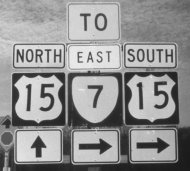 |
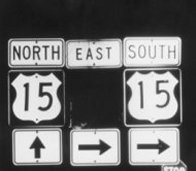 |
Remember, night reviews are still important, while a sign may appear adequate during the day, it may be non-visible at night.
These pictures of a local road were taken with in twenty feet of each other and shows how easily the growth of vegetation can block the visibility of a critical sign.
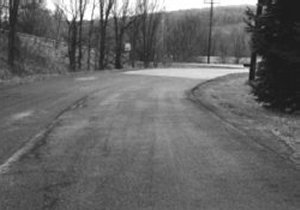 |
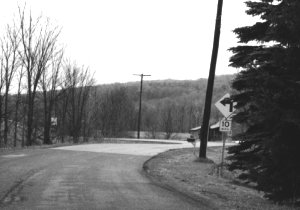 |
Sign vandalism also includes the theft of signs. Missing signs can be the result of storms or traffic incidents; however, the primary reason in many areas is simply theft. While theft can't be eliminated it may be substantially reduced by making it difficult to remove a sign and by developing and implementing laws to penalize vandals.
Specific fasteners can be used to attach signs to support posts which make it far more difficult for vandals to remove sign panels. Among the more common special fasteners in use are:
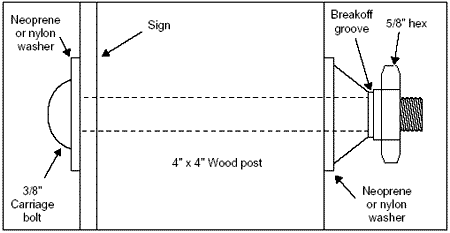
Simple details of anti theft anti vandal fasteners
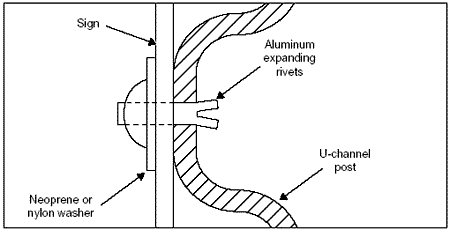
Expanding anchor and blind Aluminum Rivets
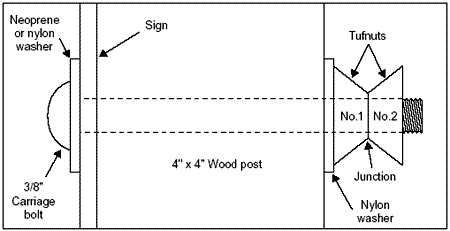
Fluted nuts (double pyramid shapes)
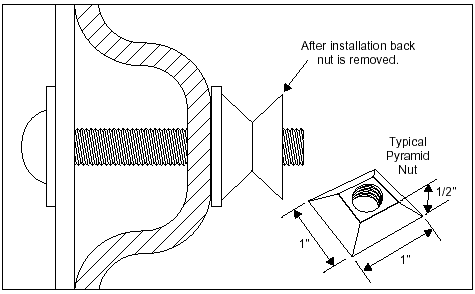
Shear off heads
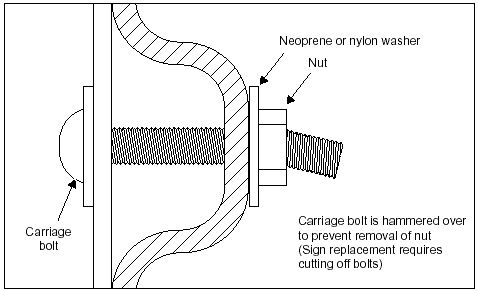
Bent over bolts
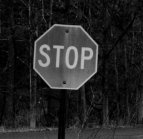 |
When a sign face becomes so worn or faded that the message is not legible or can be misread during daytime or night, the sign should be replaced. A sign needs to be readable in ordinary sunlight and still reflect enough light at night to be a useful sign. |
Nighttime visibility
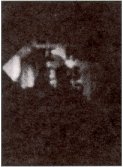 |
Signs that may appear bright and clear during the day may lose their retroreflective characteristics after long exposure to sunlight and/or salt splashes. Nighttime retroreflectivity can be inspected by using the criteria provided in Section II, Vandalized Signs. Reviews should also focus on identification and removal of non-standard signs, such as the one below. |
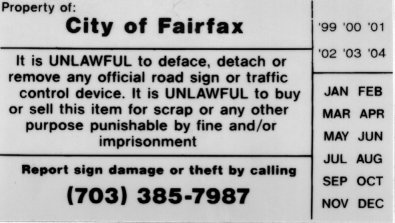
The location of signs is usually established by the guidance set forth in the current edition of the "Manual on Uniform Traffic Control Devices," State standards and/or directives, and legal procedures and/or requirements.
A sign may require replacement, an additional sign may be added or a whole sign assembly (sign(s) and support) may require replacement. Do not rely on original position and height of the sign as appropriate criteria. It is important to check the location of the support and the mounting height of the sign above the roadway to ensure the sign is legible and crashworthy. Additionally, it is essential to locate small sign supports (crashworthy sign supports) so they function properly, and remember, check new sign locations to ensure there are no utility problems or sight obstructions. Before changing the location of a support or the height of a sign, check with your supervisor.
The figures below represent the recommended height and location as provided in the MUTCD.
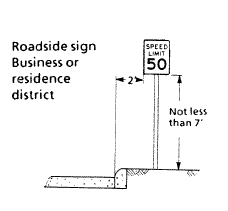
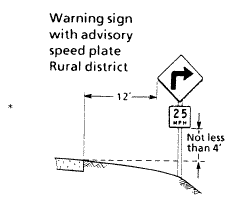
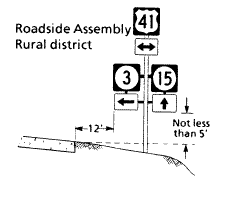
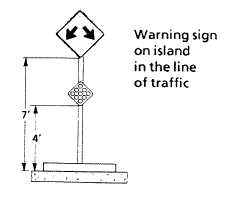
* A height of 7' or more from the bottom of the sign to the ground is recommended in all areas where there are bus stops, pedestrians or bicycle traffic.
To obtain maximum reflection from traffic signs, yet eliminate specular glare, signs should be correctly aligned. Specular glare is the mirror type reflection characteristic of any glossy surface. Under severe circumstances, such as direct sunlight, specular glare can make the sign legend unreadable. Often this becomes apparent from driver complaints.


To obtain a 93-degree angle for roadside signs, the device described below can be fabricated and used.
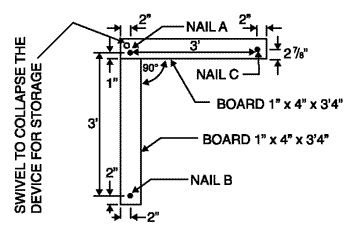
TO USE THIS DEVICE:
Position on the ground so that a line from Nail A to Nail B is parallel to the driver's line of sight (either straight along the roadway or where the driver should first see the sign). A string or straight edge can then be placed from nails A to C to establish the appropriate sign position.
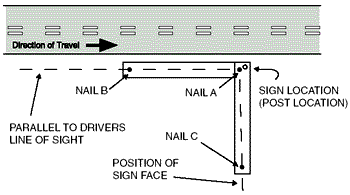
Sign Turners

Shown here is a locally fabricated tool for aligning the sign and post before final tamping. A metal U-shape the size of the wood post (4"X 4" or 4"X 6") has a pipe handle welded to it. After attaching the sign to the post, filling the hole, and lightly tamping the material, one person checks the sign to make certain it is facing the roadway at the proper angle to be seen at night while the other person rotates the post with the tool.
- 1 Pc. - 1 1/2" Black Pipe - 50" long
- 1 Pc. - 5/8" x 3" x 10" long
- 1 Pc. - 3/4" x 3/4" x 5/8" long
- 1 Pc. - 1/4" x 3/4" x 20" long
- 1 Pc. - 3/8" x 3/8" x 3" long
- 1 - Clevis slip hook (remove eye)
Wood Post
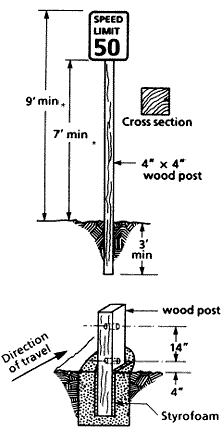 * For rural areas, the minimum height from bottom of sign may be 5'. |
Small supports. Cross section is 16 sq. inches. Posts should be buried in firm ground. Minimum recommended depth is three feet. You may need to bury deeper to reduce vandalism. Do not encase post in concrete. One or two posts may be used. Large Supports should be drilled. A 6" X 8" wood post can be used if the cross section is weakened by drilling two 3-inch holes as shown in the lower drawing (drill perpendicular to roadway). A 4" X 4" is the largest undrilled wood post recommended to act as a breakaway support. Maximum Post SizesMax. Sign Panel Post Size 18" X 24" 4" X 4" nom. 30" X 30" 4" X 6" nom.(2" holes) 36" X 48" 6" X 6" nom.(2" holes) Sign Panels. Sign panels should be bolted to the post with oversized washers. This will prevent the panel from separating from the post on impact and then penetrating a windshield. Set the bottom of the sign panel a minimum of 7 feet above the pavement or ground. This will limit the chance of the sign and post rotating and hitting the car's windshield. |
U-Channel Steel Post
The U-channel, hot rolled steel post is the second most common small sign support. It is considered breakaway since it will bend, break or pull out of the ground when it is hit.
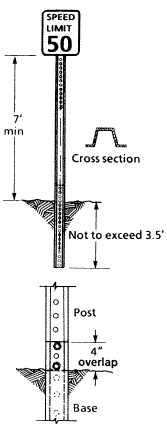 * One post at each end of sign; not a single post made of two rails bolted together |
Post Support. The post should be driven into the ground and not encased in concrete. Drive posts into the ground no more than 3.5 feet to make it easier to pull out damaged posts. Breakaway Devices. Splices can be purchased commercially to install at ground level (see lower drawing). They allow the post to break off on impact. These devices improve safety when the post is hit, will make repair easier, and will make it possible to use a U-channel post when it has to be placed in a concrete area. An alternate installation is to set a stub post in the concrete with a 4-inch length available to bolt to the sign post as a base connection. Maximum Post Size Max. Size Panel Post Size 18" X 24" 2 lb/ft 30" X 30" 3 lb/ft 36" X 48" 2 @ 2 lb/ft* Sign Panels. Sign panels should be securely bolted to the post with oversized washers. This will prevent the panel from separating from the post on impact and then penetrating a windshield. Set the bottom of the sign panel a minimum of 7 feet above the pavement or ground. This limits the chance of the sign hitting a car's windshield. |
Square Steel Tube
Another sign post is the square steel tube (perforated) design. It is used in many localities.
 |
Post Support. Posts can be driven into the ground. Do not place concrete around the post. A broken or damaged post is easier to remove if it is not driven or set into the ground more than three feet. Breakaway Devices. Sleeve assemblies like the one shown in the lower drawing will increase the safety of a sign when it is hit and make it easier to repair. After the sign has been hit, the broken stub of the post can be removed from the base sleeve and a new sign post put back in place. Maximum Post Size Max. Sign Panel Post Size 30 " X 30" 2.25" X 2.25" X 0.105" Sign Panels. Attach the sign panels tightly to the post and use oversized washers to keep the sign from breaking loose from the post when a vehicle hits it. Sign panels should be mounted a minimum of 7 feet above the pavement or ground. |
There are many other products available commercially for sign supports. Use depends on local requirements and costs. This publication only shows four of the most common types of small sign supports.
Slip Bases
When installing, replacing or repairing sign support systems always follow the manufacturer's instructions to ensure proper performance.
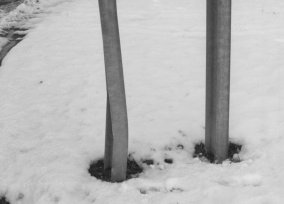
In this case, the slip base supports are under several inches of back fill, consequently failed to activate when hit, note the bending of the left leg.
Typical torque requirements for slip base breakaway systems.
| Post Size Pounds per Foot |
Slip Base Bolt Diameter (in) |
Clamping Force (pounds) |
Bolt Torque (inch-pounds) |
Max Torque (ft-pounds) |
|---|---|---|---|---|
| 1 - 8 | 1/2 | 920 - 1380 | 95 - 142 | 12 |
| 9 - 20 | 5/8 | 1740 - 2660 | 226 - 345 | 29 |
| 21 - 30 | 3/4 | 2400 - 3600 | 369 - 554 | 46 |
| 30 + | 1 | 2400 - 3600 | 460 - 735 | 60 |
Some practices or efforts to improve maintenance can reduce the positive safety aspects of crashworthy sign and sign support designs. The following examples will give you an idea of the kind of things to watch out for. Look carefully around your own areas of responsibility to ensure that past efforts have not compromised the crashworthiness of the design or situation.
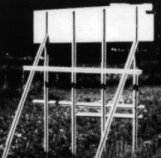
|
This sign has multiple posts supporting it when two are probably enough. Also, two horizontal braces cross the bottom. These increase the strength of the support greatly, but a small car hitting this is likely to stop suddenly, causing a severe accident. Larger posts with breakaway mechanisms at the ground are better. |
The environment can also be a factor on the safety characteristics of sign supports. The two most common conditions that can affect the crashworthiness of a sign support are erosion of soil at the base and the growth of trees around the support.
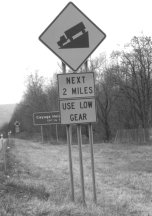 |
Use of too many supports, either on one sign or for a group of signs can produce a hazard. This supporting system is too rigid and may contribute to overturning, loss of control or abrupt stopping. |
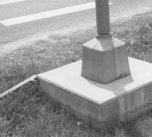 |
While the system used is a breakaway base the pedestal it is mounted on was either not back filled around or the soil has eroded around it. This support system is now a hazard as it constitutes a rigid concrete block more than four inches above the surrounding ground. This can snag the under-carriage of a vehicle causing it to stop abruptly or go out of control. |
Signs are very important to motorist, bicyclist and pedestrian safety, particularly regulatory and warning signs. These signs can fade, be painted over, get knocked down, be stolen, be blocked from view because of vegetation or man-made features, cease to apply to the current situation, or be dirty. Occasionally, someone may even add signs that are not appropriate or consistent with the control of traffic or driver's needs. Checking the existing signs against sign inventory can identify any discrepancies and resolve those discrepancies before they contribute to an accident.
Signs should be checked at least twice a year as conditions dictate. Desirable times are after winter and before the start of the school year. (This cycle provides for identifying winter damage and blocked visibility as a result of new vegetation growth.) As previously mentioned, special reviews should be conducted after bad storms when drifting snow blocks visibility or trees are blown down.
During sign checks it is also desirable to clean dirty signs and refurbish faded or damaged signs. The inspectors should keep a record of all actions taken and recommended. These records should be added to the sign inventory.
For routine patrols, take several sign posts commonly used in your patrol area. Remember there may be several types in common use in the area including wood, steel U-channel, perforated square tube, etc. Suggested numbers of posts for large areas include:
Supplies and Sign Hardware Items
You should take enough hardware to replace a minimum of 20 sign panels and 10 sign supports. When your hardware supply falls below this level, obtain more before beginning a patrol. You will also need to carry a supply of:
If you plan to make field repairs to damaged sign faces (repair the legend or lettering) rather than do this in the shop, you will need additional field supplies, including:
Materials
Suggested hand tools for sign maintenance patrols:
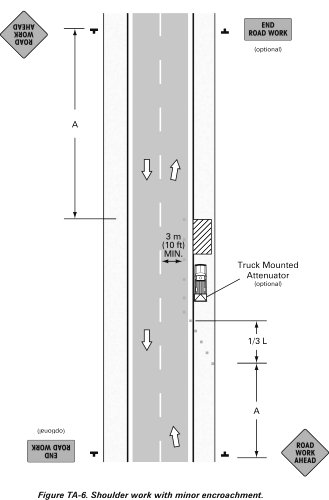 |
Guidance:
Option:
Standard:
|
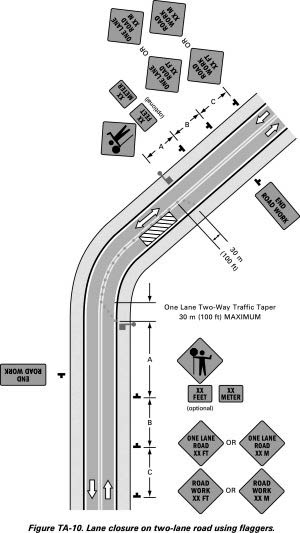 |
Option:
Guidance:
|
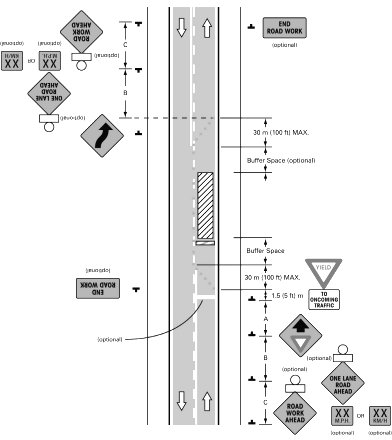 |
Option:
Standard:
Option:
|
Keeping records of sign maintenance and inspections is important, particularly small signs as these are the ones most often affected by weather and vehicular accidents. Keeping good records will help you:
The three main elements of maintenance records include:
It is very important to develop and maintain a sign inventory. Without a record of the type, size, location, and age of a sign, it is often difficult to know what signs are missing or where maintenance efforts can be best applied. A sign inventory can help you respond quickly and more effectively to an incident report. It can help identify areas where there are vandalism or accident problems. Depending on the size of the community and the equipment available, a sign inventory can be developed on ledger books, file cards, microcomputers or mainframe computers. As long as the people using it know how it works and maintain current information on it, it can be effective. Information that should be included in the inventory includes:
Small communities with less than one-hundred to one-hundred and fifty signs may choose to use simple three by five inch cards to maintain information on each sign. Larger inventories of signs can be managed on computer systems available by both sign vendors and through local Technical Assistance Programs.
Incident reports should include:
This type report could read as follows: "The STOP sign (inv. #3412) on the Northwest corner of the intersection of Oak St. and Elm St. was reported bent by a concerned citizen. The sign was checked and straightened by J. Smith on January 16, 2000."
Maintenance records should be kept for any new installations, repairs of existing installations, or replacement jobs done on signs and sign supports. This will help to determine changes in your maintenance activities that improved driver and work safety, reduced costs, and reduced potential for liability lawsuits. A sign (and sign support) maintenance record, report, file, or log should include, as a minimum, the following information:
This document is disseminated under the sponsorship of the Department of Transportation in the interest of information exchange. The United States Government assumes no liability for its content or use thereof.
The contents of this report reflect the predominant views of City, State and federal authorities at the time of publication and as such are technical opinions on best methods of approaching current technical issues. The opinions expressed herein should therefore not be construed as Federal or State policies. The contents do not necessarily reflect the official policy of the Department of Transportation.
This report does not constitute a manual, handbook, standard, specification, or regulation.
The United States Government does not endorse products or manufacturers. Trademarks or manufacturer's names appear herein only because they are considered essential to the objective of this document.
Prepared under the Local Transportation Assistance Program for use by Technology Transportation Centers
